Robotic vacuum cleaners do not try to pass through walls and distinguish between obstacles. In this they are helped by “vision” sensors and software methods for building maps. In this regard, we have already talked more than once about robotic vacuum cleaners with lidars and their ability to perfectly navigate the terrain.

This time we tested the iBoto Smart L920SW Aqua model with the wet cleaning function. Let’s see how quickly and cleanly it will sweep our gray carpet and whether it is convenient to control it from the remote control and from a mobile phone.
Characteristics
| Manufacturer | iBoto |
|---|---|
| Model | Smart L920SW Aqua |
| Type | robot vacuum cleaner |
| Country of Origin | China |
| Warranty | 1 year |
| Cleaning type | dry/wet |
| Sensor type | LDS (lidar) |
| Cleaning duration | 90-120 minutes |
| Remote control | IR remote |
| Smartphone control | there is |
| Battery | 2600 mAh |
| Power | 28 W |
| Suction power | 2500 Pa |
| Dust container volume | 800 ml |
| Water container volume | 180 ml |
| Noise level | 54 dB |
| The weight | the weight of the device without packaging, usually indicated somewhere in the documentation |
| Dimensions | ∅320×85 mm |
| Network cable length | 1.5 m |
| Retail offers |
Equipment
iBoto Smart L920SW Aqua is packaged in a laminated cardboard box with full color printing. On the front side, the manufacturer posted a photo of the device, listed all the floor coverings that the robot can handle (short-haired carpet, wood and tile floors, and stone flooring), and mentioned compatibility with the Yandex voice assistant.
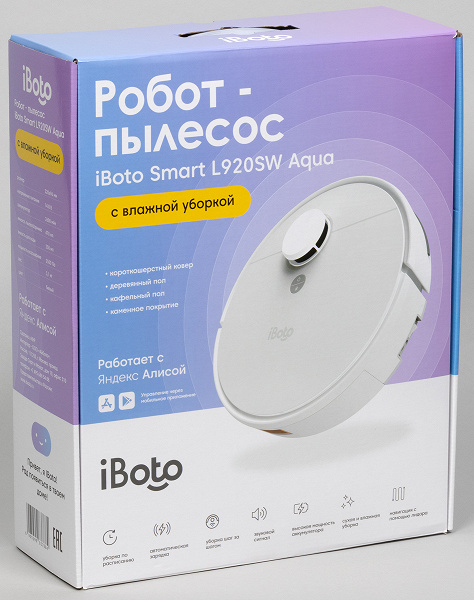
The icons located at the bottom of the front of the box list the main features of the model. In addition to the “automatic charging”, “step-by-step cleaning” and “beep” options typical of most robots, scheduled cleaning, high battery power, dry and wet floor treatment and, of course, lidar navigation are mentioned here.
The manufacturer’s contact information and brief technical specifications of the device are located on the sides of the box. The package comes with a plastic handle for easy portability.
Inside the box we found:
- the vacuum cleaner itself with installed side brushes, a dustbin and a wet cleaning unit
- spare set of side brushes
- base for charging
- power adapter
- spare air filter
- extra microfiber cloth for wet cleaning
- device cleaner
- infrared remote control
- user guide
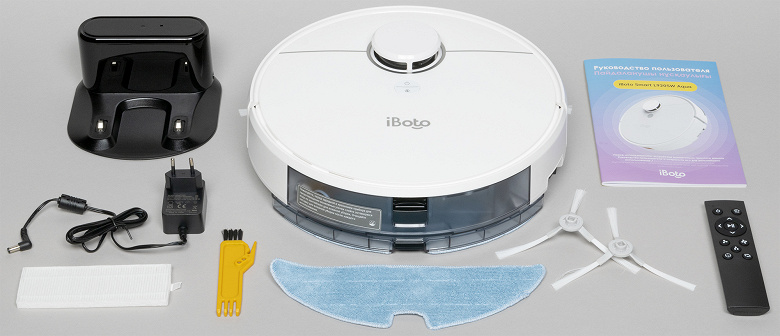
In addition to the minimum accessories necessary to get started, iBoto Smart L920SW Aqua comes with a complete set of consumables: brushes, a rag and a filter.
At first sight
Robot vacuum cleaner iBoto Smart L920SW is traditionally round, with a classic layout. It has two side brushes and one central. When driving, this model relies on two driving wheels and one swivel – it is familiar to the front. The white body is designed laconic and is not decorated with anything – except for the manufacturer’s logo on top.

Above the top panel rises the turret of the lidar, the main body of the orientation of the robot. A cylinder with a laser emitter and a photodetector rotates in it: with their help, the vacuum cleaner builds a three-dimensional picture of the room and determines the distance to obstacles. The sensors are not covered by protective glass and are clearly visible.
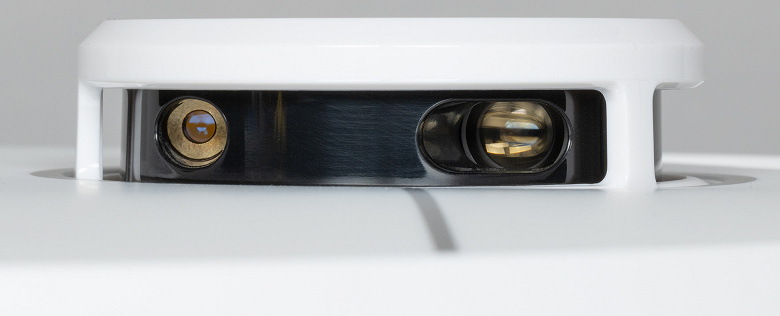
The front half of the body is occupied by a bumper, inside of which mechanical collision sensors are placed. Behind the dark IR-clear glass are infrared sensors that complement the device’s orientation system and make it easier for it to find the base station.

On the right side of the device, we see a toggle switch for turning on and a connector for connecting a network adapter. This model can be charged both on the base and manually by directly connecting the power source to the vacuum cleaner.

A strip of porous material is glued below the bumper glass to protect the appliance and furniture in the event of a collision.

As already mentioned, this model relies on three wheels. The “tires” of the leaders are equipped with deep lugs: they give the robot confidence on any floor coverings, and their suspension allows you to change the clearance from 7 to 35 millimeters. The guide is mounted in a plastic sphere that can rotate 360°.

Along the perimeter of the bottom side are surface sensors that prevent the robot from falling from a height. On the sides of the steering wheel, you can see two charging contacts on the base. The white side brushes are slightly different in geometry and are marked so as not to confuse them during installation. They are fastened with snaps and hold tightly.

The frame of the central brush does not have any protection against accidental winding of electrical wires. On the brush itself there are three V-shaped rows of bristles of medium hardness, without lamellae.

The battery of the device is an assembly of four 18650 cells covered with shrink wrap.

The main compartment of the garbage collector opens from the inner end. In the upper part of the module, under a separate cover, there are filters: preliminary made of white nylon mesh, black foam rubber and white for fine cleaning. Approximately a quarter of the volume is occupied by a water tank, which is closed with an oval light-colored rubber stopper.
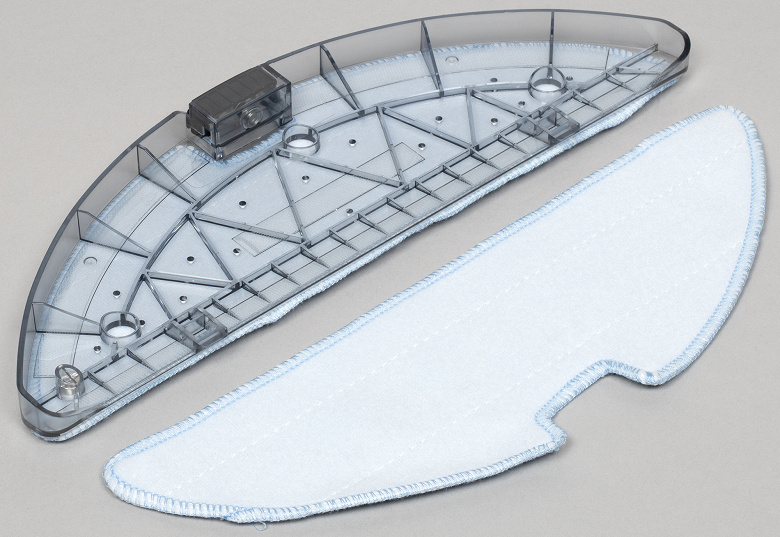
The wet cleaning block is a rather thin D-shaped frame. It does not have a separate water tank and injection devices – water flows by gravity onto a fiber rag attached to the block with Velcro.
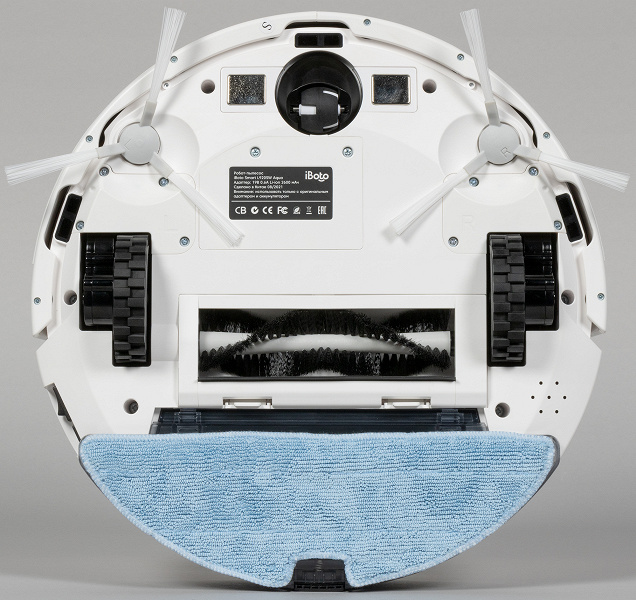
The frame for wet cleaning is fastened to the main trash container using latches.

The bottom of the base station is equipped with four rubber inserts that prevent slipping.
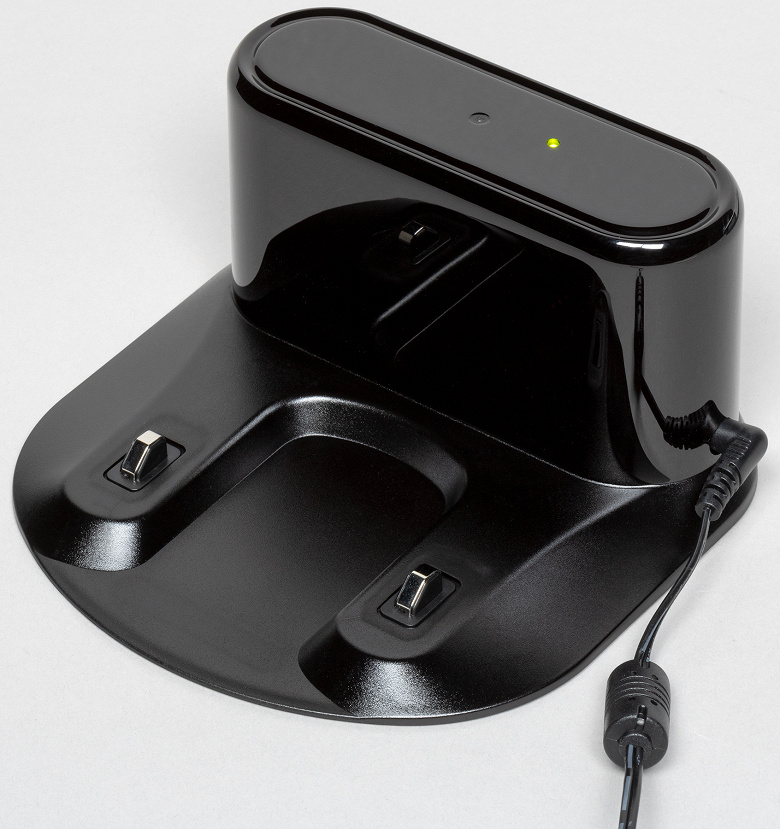
The top of the base is made of IR transparent plastic. Under it are sensors that provide positioning of the robot when returning to charge. When connected to the network, the LED on the base lights up. The contacts are spring-loaded, with a stroke of about 3 mm.

The vacuum cleaner kit also includes a simple cleaning tool, consisting of a brush, comb and blade, with which it is convenient to free the rotors from hair and threads wound around them.
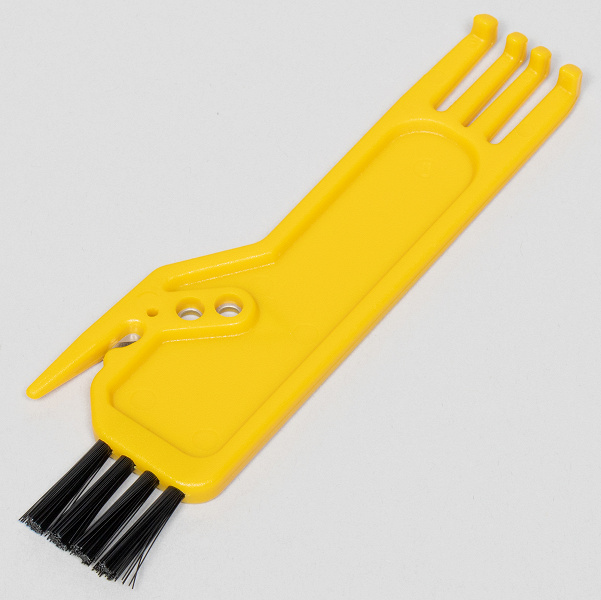
Instruction
iBoto Smart L920SW Aqua User Manual is an A5 brochure on thick paper with good printing quality.

The Russian-language document contains all the necessary information: about the design of the vacuum cleaner, its efficient operation, safety measures when handling the device, and caring for it. A short list of malfunctions with methods for their elimination and detailed technical specifications of the device complete the instruction.
The paper version of the documentation contains a number of errors regarding the use of the application to synchronize the vacuum cleaner with a smartphone (more on this below). If you have any difficulties using the iBoto Smart L920SW Aqua, we recommend that you follow the electronic version of the document available on the manufacturer’s website: the shortcomings we noticed in it have already been corrected.
The user manual also serves as a warranty booklet: the last two pages are intended for marks of the seller and the service center.
Control
On the top panel of the device, next to the lidar turret, there are two buttons: one of them turns on the robot and starts the automatic cleaning mode, the second is designed to return to the base.
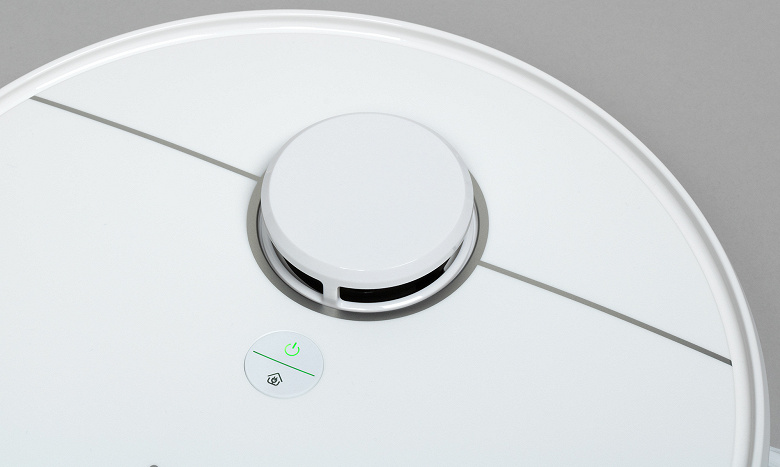
A long press on the power button starts the synchronization mode with the mobile application (it will be discussed below).
Remote control
A simple infrared remote control is supplied with the model. Two buttons in its upper part – power on and return to base – duplicate those on the top panel of the device.
The navigation buttons in the middle part allow you to control the movement of the robot manually, and the central one starts cleaning in automatic mode (pressing it again stops the work).
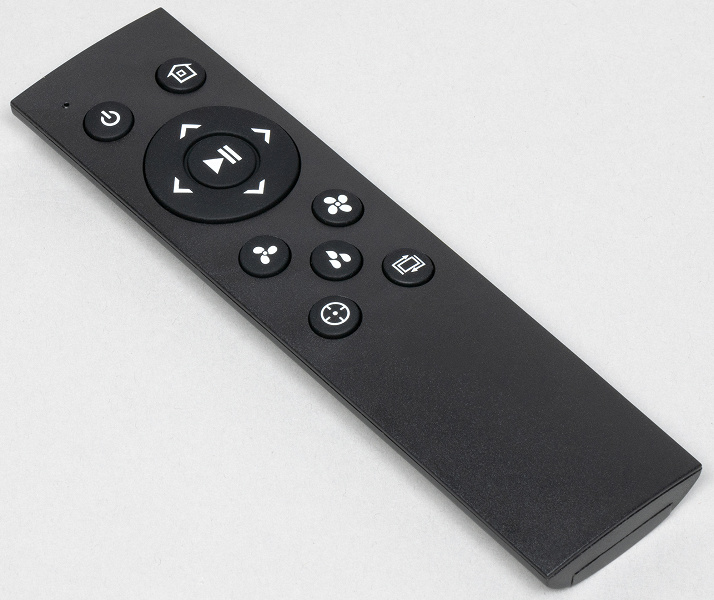
Under the navigation block there are keys that control the suction power (our model has three levels in total) and the inclusion of wet cleaning.
The two bottom buttons control the path of the robot: one starts the local cleaning mode, the second sends the device to sweep and wash along the walls.
Smartphone control
At the stage of synchronizing the vacuum cleaner with the mobile application, there was an unfortunate hitch. Taking the paper version of the manual, we used the QR code leading to the application page, downloaded and installed the developer’s Dibea with a long Chinese name. After registering in it, we tried to find our model in the list of supported robot vacuum cleaners (unsuccessfully). Also, attempts to synchronize the smartphone with the device, following the detailed step-by-step instructions from the manual, did not bring success.
Paying attention to the fact that the documentation mentions an application with a different name, we found the iBoto Smart program of the same developer on Google Play (the rating at the time of writing the review was 2.4 out of 5, the number of installations was more than 1000), installed it, registered and successfully synced the device.
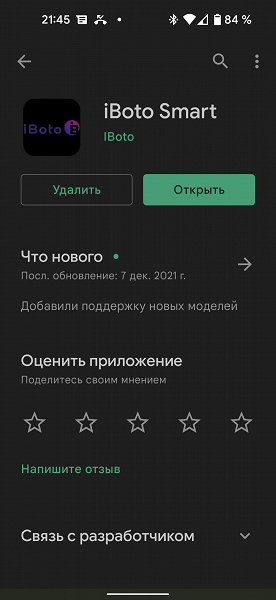
The confusion arose due to the fact that iBoto Smart is a complete copy of the Dibea application, localized for the Russian market. The interface of all program pages, the registration process and the connection procedure are completely identical – they differ only in the list of supported devices. Moreover, the same login and password combination that we used when registering with Dibea is suitable for iBoto Smart – both applications, apparently, use a single server infrastructure.
The QR code from the electronic version of the user manual , which is available on the manufacturer’s website, already contains a link to the correct version of the application. We hope that this problem will be promptly corrected in the next printing of paper instructions.
To work, the application requires registration with a verified email address, as well as providing data on the location of the smartphone and searching for devices nearby. At startup, an optional permission is also requested to transfer product usage data to the manufacturer. Using the “add device” button, we easily found the iBoto Smart L920SW Aqua in the short list of supported robot vacuums and proceeded to the synchronization procedure.
Connecting the robot to the application is easy and does not take much time: the program provides simple and detailed instructions. The user only needs to turn on the pairing mode on the vacuum cleaner and tell the application the SSID and password of the Wi-Fi network in which it will be used.

After successful synchronization, we get to the main page of the application, where the vacuum cleaner has already managed to draw the first sketch of the map. Like all robots with an LDS sensor, iBoto Smart L920SW Aqua builds a detailed layout of the room without moving: an accurate laser sensor allows you to navigate in space without touching the furnishings with a bumper.

Under the map, the duration of the current cleaning, the area that the vacuum cleaner has managed to bypass, and the battery status are displayed. The icons at the bottom of the screen allow you to start the device in automatic mode (“Smart cleaning” item), select the local cleaning mode and return the device to the base.
If you need to prohibit the vacuum cleaner from visiting certain areas of the room, you can use the “virtual wall” tool by drawing a line on the map that the device should not cross, or mark a rectangular restricted area on the room plan.

On the settings page, you can adjust the volume of voice messages, suction power and water consumption during wet cleaning, select a voice package (English and Russian languages are available), view information about previous sessions (end time, duration and area), and set the time in which the vacuum cleaner should not start (do not disturb mode).

On the Manage Maps page, you can switch between floor plans. This feature is useful for owners of multi-level apartments and multi-storey cottages: easy change of floor maps allows you to provide the device with information about the room with all settings and restricted areas without prior scanning. The application supports up to ten cards.

Scheduled cleaning is configured using the “Timer” item on the settings page. You can run a cleaning script at a specified time on a specified day of the week. We found it convenient to schedule cleaning twice a day: in the evening, after dinner, and in the morning. On weekdays, morning cleaning was scheduled for ten in the morning, and on weekends, when you want to sleep longer, at half past eleven.
Working with Alice
At the time of writing the review, support for the Yandex voice assistant had not yet been announced, but the manufacturer told us about the implemented compatibility of the iBoto Smart L920SW Aqua with Alice. Of course, we did not miss the opportunity to check what opportunities the robot has when connected to it.
To integrate our vacuum cleaner with the Yandex service, in the settings, select “Add a smart home device”, find the iBoto Smart plugin (“skill” in Alice’s terminology) and follow the step-by-step instructions. During the linking process, you will need a password for the account we created during the installation of the mobile application.
After successfully connecting the plug-in, you need to select the room in which the vacuum cleaner will work and name it (it is recommended to use Cyrillic).

The electronic “control panel” is the only virtual button that starts cleaning in automatic mode. Much more opportunities are provided by the “voice commands” tab, which shows examples of interaction between a vacuum cleaner and an assistant.

With verbal commands, we can turn automatic cleaning on and off, find out about the status of the vacuum cleaner, and also schedule work on a schedule.

Exploitation
After removing the vacuum cleaner from the box, it must be removed from packaging materials, including bumper protectors, and if necessary, put on the side brushes in accordance with their configuration: the rotor marked with the letter “R” should be on the right, and the letter “L” indicates the left brush. In the instance that arrived to us for testing, they were already in the appropriate places.
The base should be placed against the wall so that there is at least 1 meter of free space to the right and left of it, and at least one and a half meters in front. It should not be installed near reflective objects, such as near mirrors. The device should be protected from direct sunlight.
Like any cordless device, the vacuum cleaner must be fully charged before use. The manufacturer warns that the first charge can last six hours, so we just left the vacuum cleaner to power overnight.
The navigational abilities of the iBoto Smart L920SW Aqua are beyond praise. Like any robot with lidar, it instantly determines the boundaries of the room, sees possible obstacles and builds a route so as not to sweep clean. Thanks to the excellent algorithm for building cleaning in automatic mode, it does not take much time.
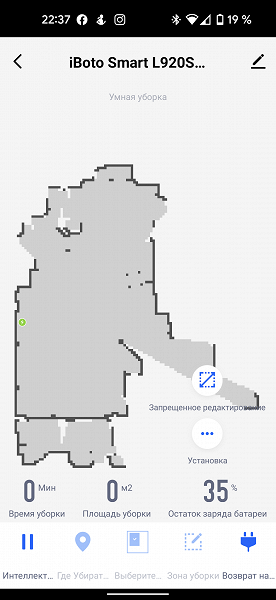
Once in an unfamiliar room, the vacuum cleaner instantly orients itself in it, drawing borders in the application as the laser sensor “sees”. Even before the start of movement, sections of neighboring rooms also appear on the map, into which the sensor allows you to look. During the cleaning process, the map is being updated.
The device, launched in automatic mode by pressing a button on the case or on the remote control, goes around the room around the perimeter, then bypasses it with a “snake”, leaving no gaps, and returns to the base when the route has been completed. Information about the current cleaning is displayed in the application, regardless of how the vacuum cleaner started working: using a mobile phone, using a button on the body or a remote control.
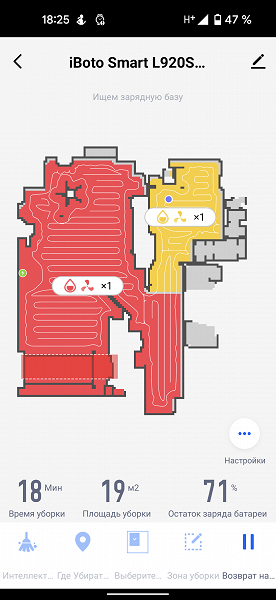
The small diameter allows this model to freely visit narrow nooks and crannies and easily get out of them. Obstacles, such as chair legs, which are difficult for some other robots, are not a problem either. But the limitations of the upper dimension can cause certain difficulties for iBoto Smart L920SW Aqua: it does not accurately determine the height of an obstacle and can get stuck under a sofa or cabinet. In this case, having identified a dangerous area, you should use the application and use the “virtual wall” or “restricted zone” tools to close the necessary areas for the vacuum cleaner.
With the help of the “cleaning zone” tool, you can draw a rectangular area on the map in which you need to put things in order. After pressing the save button, the robot will immediately head in the desired direction and will only work there.
In the wet cleaning mode, the robot wipes the surface evenly, without streaks and drops, while collecting dry debris.
The vacuum cleaner reports aloud about the progress of cleaning and emerging difficulties. The device has two voice packages – Russian and English. In case of an emergency (for example, in case of getting stuck), the robot notifies the owners about the problem by verbal message or push notification.
If the device has stopped for more than three minutes, the indicators will turn off and the robot will enter sleep mode. To wake him up, just press any button on the case or remote control. You can also use the app.
Care
The side brushes should be cleaned if dirty and replaced if damaged.
The dust container must be emptied and cleaned after each cleaning. To do this, it is removed from the body, checking if foreign objects are stuck in the suction hole, and the debris is shaken out. The body of the garbage collector and the nylon pre-filter can be washed under the tap.
The HEPA filter should be cleaned every 15-30 days, and the manufacturer recommends replacing it every six months, at least.
The height sensors and charging contacts on the bottom of the device should be cleaned regularly with a soft, dry cloth. In the same way, you need to clean the contacts of the base – if necessary.
None of the parts of the appliance should be washed in the dishwasher.
The life of consumables is, according to the manufacturer’s recommendations, 1 year. The brushes, filters and damp cleaning cloth should then be replaced. A set of consumables can be purchased on the manufacturer’s website .
Our measurements
We present the results of testing the device according to our methodology, which is described in detail in a separate article . Before starting the tests, we let the vacuum cleaner walk around the test site for a few minutes to familiarize ourselves with the layout of the room and the configuration of the obstacles.
Having completed the bypass of the entrusted territory, the vacuum cleaner reported on the completion of work and went to the base. The video below was filmed from one point with full coverage of the retractable space; during processing, part of the video sequence was accelerated by 16 times.
The vacuum cleaner went around the perimeter of the test area, looking into the narrow “trap” in the far left corner, and then carefully “snake” the entire area, leaving no uncleaned areas, with the exception of a small area around the base. Cleaning lasted 7 minutes 10 seconds, after which the robot notified that the work was done and returned to the base.
In the first seven minutes or so, the vacuum cleaner cleaned the room with high quality, collecting 95.8% of the garbage. After that, we repeated the experiment.
The program execution time was 7 minutes 15 seconds – almost the same as the first time, and . On the second cycle, the amount of garbage collected increased to 98.4% – an excellent result.
At the end of the tests, a small amount of dirt remained on the floor. Most of them were concentrated on the site next to the base, which iBoto Smart L920SW Aqua went around in a small circle, about half a meter in diameter. From the base, it starts with the suction turned off, switching to operating mode at a distance of the same half a meter. When cleaning is over, the vacuum cleaner turns off this function when approaching the charger. This explains the noticeable amount of debris in front of it.

The results of both stages are presented in the table.
| Interval | Total cleaning time, min. | % (total) |
|---|---|---|
| First | 7:10 | 95.8 |
| Second | 14:25 | 98.4 |
The maximum duration of autonomous cleaning at minimum power, recorded by us during test operation, was 1 hour 20 minutes. But in the maximum power mode, the duration of operation is small – a little less than 40 minutes.
Depending on the selected mode, the noise emitted by the model varies from 58 to 66 dBA. Even at maximum power near a running vacuum cleaner, you can talk without raising your voice. The sound is even, without pronounced peaks.
The robot, which stood on the base after the end of work in automatic mode, is charged on average within 2 hours and 50 minutes. During charging, the base of the device consumes about 15.9 W, in standby mode, its power consumption is 0.6 W.
findings
The robot vacuum cleaner iBoto Smart L920SW Aqua showed excellent cleaning quality even in comparison with other models of vacuum cleaners equipped with lidar. High accuracy of navigation and thoughtful route planning allow the device to quickly and efficiently bypass the premises without passing through the same area twice.
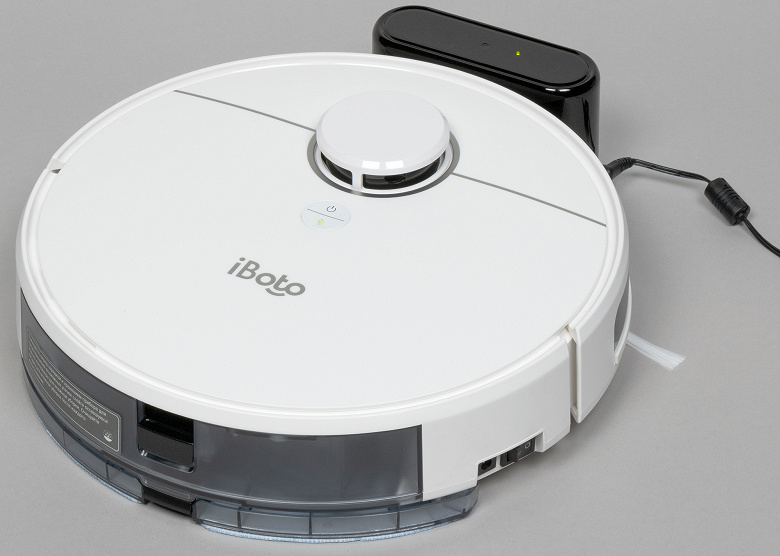
A convenient and functional mobile application allows you to easily control the cleaning process, manage maps of premises and set zones that are prohibited for dry and wet cleaning. The disadvantages of the device, we will attribute perhaps not too long battery life in maximum power mode.
Pros :
- low price
- excellent navigation and cartography
- excellent cleaning quality
- low noise
Cons :
- relatively short battery life in maximum power mode
In conclusion, we suggest watching our video review of the iBoto Smart L920SW Aqua robot vacuum cleaner:
Our video review of the robot vacuum cleaner iBoto Smart L920SW Aqua can also be viewed on iXBT.video





